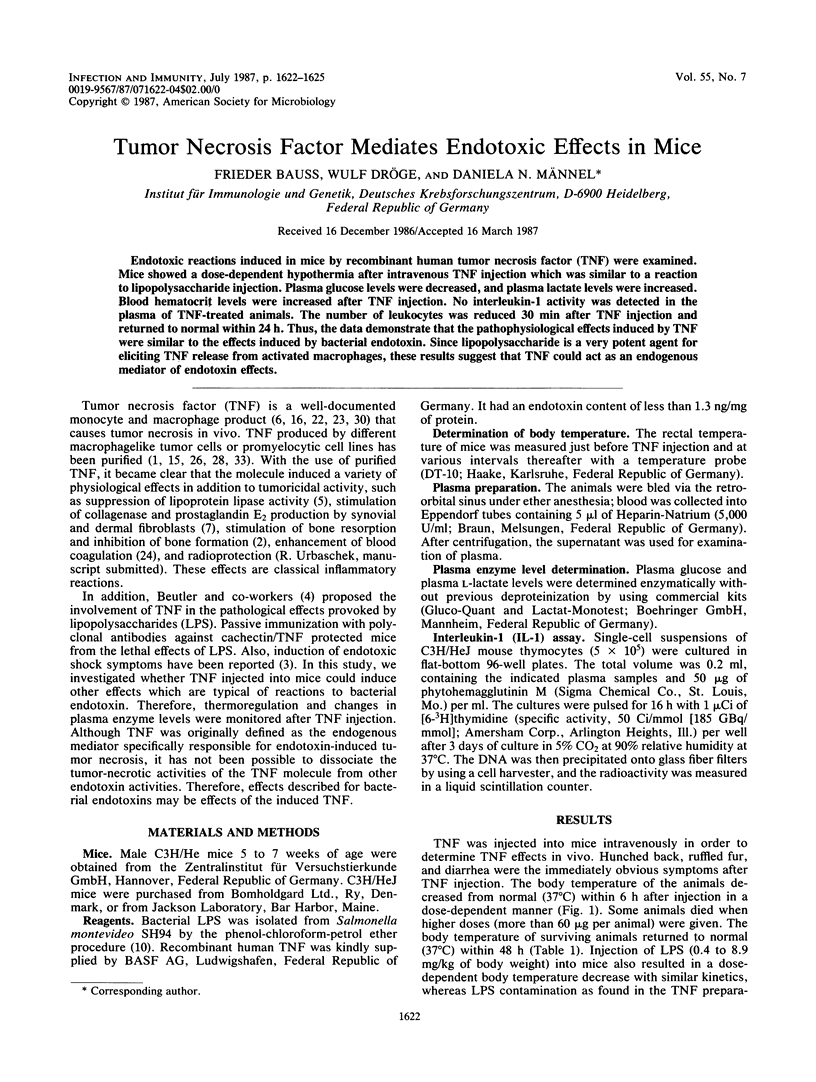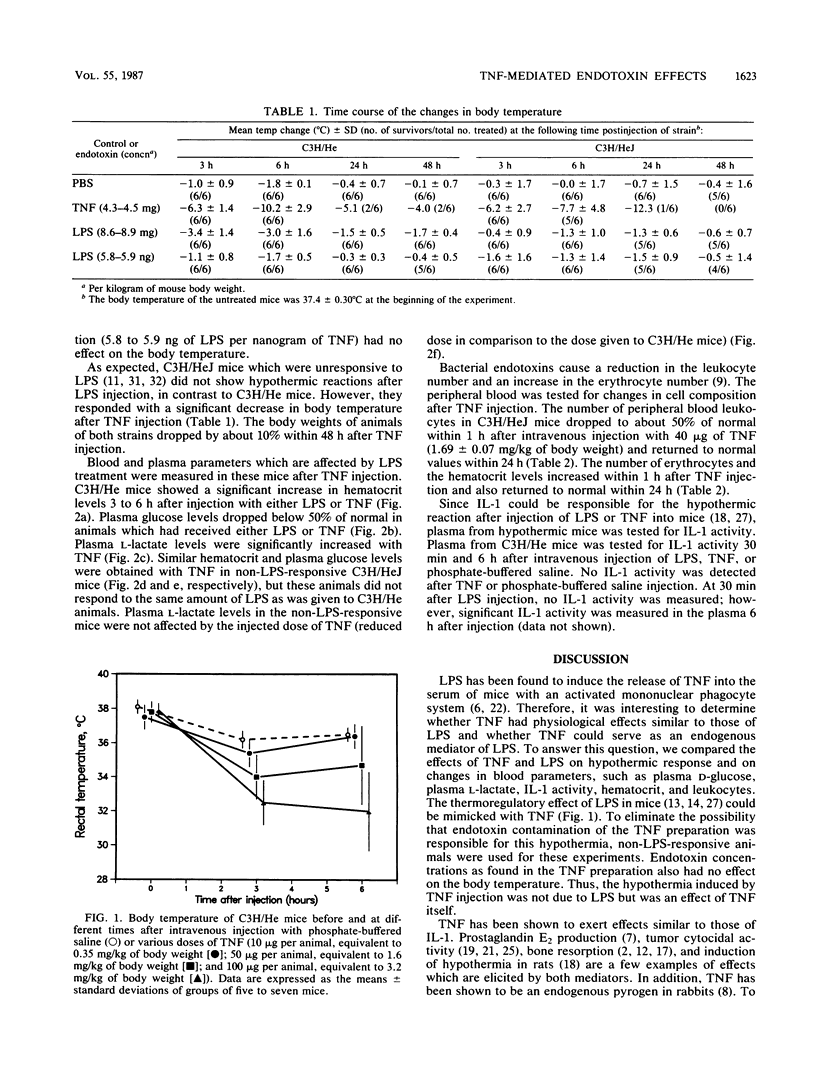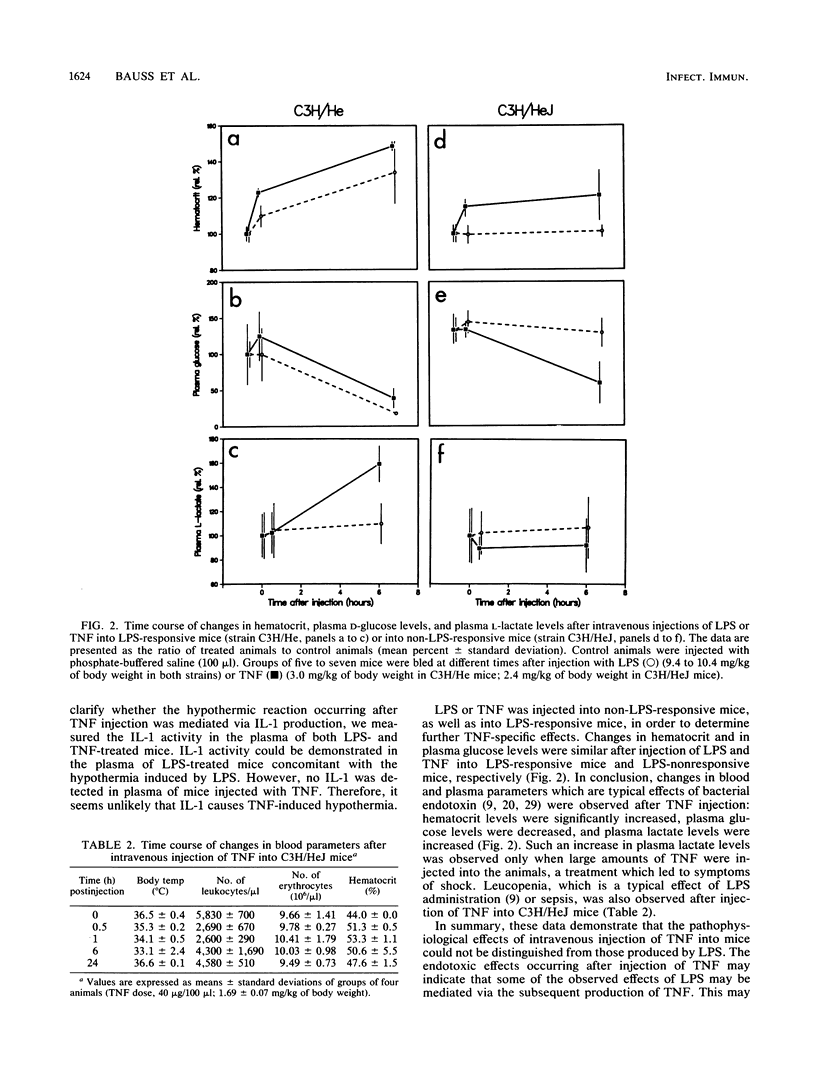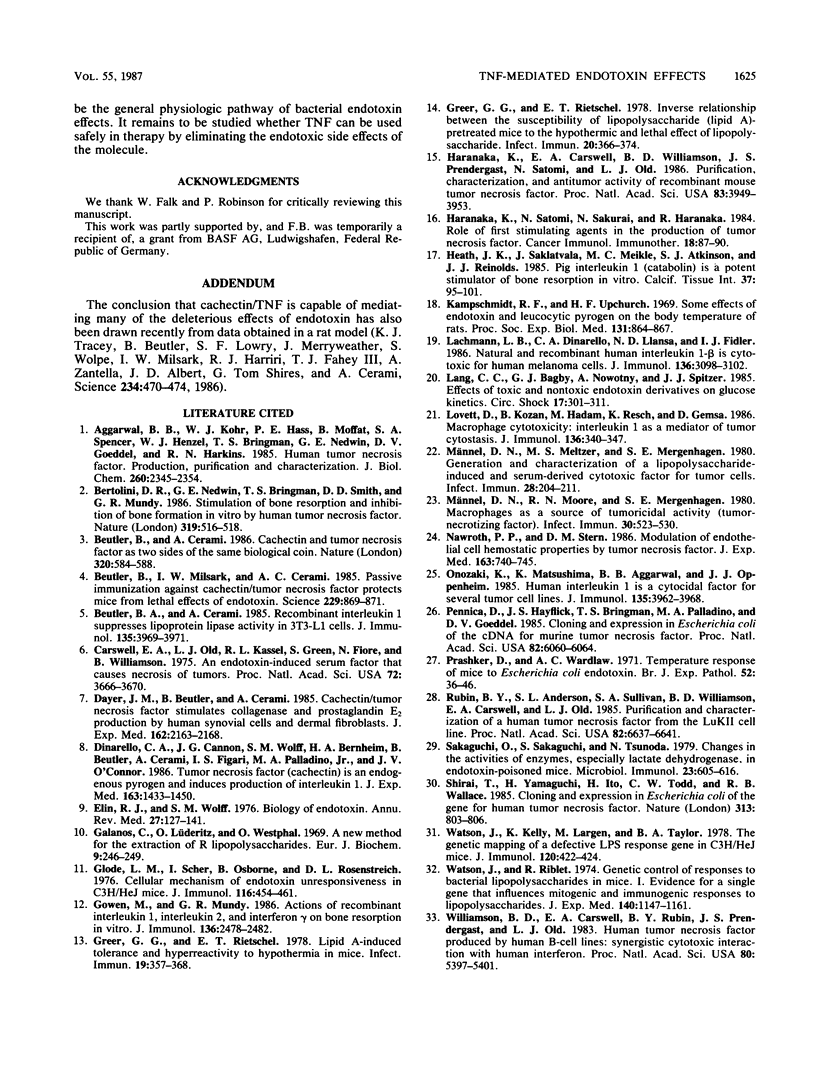Abstract
Endotoxic reactions induced in mice by recombinant human tumor necrosis factor (TNF) were examined. Mice showed a dose-dependent hypothermia after intravenous TNF injection which was similar to a reaction to lipopolysaccharide injection. Plasma glucose levels were decreased, and plasma lactate levels were increased. Blood hematocrit levels were increased after TNF injection. No interleukin-1 activity was detected in the plasma of TNF-treated animals. The number of leukocytes was reduced 30 min after TNF injection and returned to normal within 24 h. Thus, the data demonstrate that the pathophysiological effects induced by TNF were similar to the effects induced by bacterial endotoxin. Since lipopolysaccharide is a very potent agent for eliciting TNF release from activated macrophages, these results suggest that TNF could act as an endogenous mediator of endotoxin effects.
Full text
PDF



Selected References
These references are in PubMed. This may not be the complete list of references from this article.
- Aggarwal B. B., Kohr W. J., Hass P. E., Moffat B., Spencer S. A., Henzel W. J., Bringman T. S., Nedwin G. E., Goeddel D. V., Harkins R. N. Human tumor necrosis factor. Production, purification, and characterization. J Biol Chem. 1985 Feb 25;260(4):2345–2354. [PubMed] [Google Scholar]
- Bertolini D. R., Nedwin G. E., Bringman T. S., Smith D. D., Mundy G. R. Stimulation of bone resorption and inhibition of bone formation in vitro by human tumour necrosis factors. Nature. 1986 Feb 6;319(6053):516–518. doi: 10.1038/319516a0. [DOI] [PubMed] [Google Scholar]
- Beutler B. A., Cerami A. Recombinant interleukin 1 suppresses lipoprotein lipase activity in 3T3-L1 cells. J Immunol. 1985 Dec;135(6):3969–3971. [PubMed] [Google Scholar]
- Beutler B., Cerami A. Cachectin and tumour necrosis factor as two sides of the same biological coin. Nature. 1986 Apr 17;320(6063):584–588. doi: 10.1038/320584a0. [DOI] [PubMed] [Google Scholar]
- Beutler B., Milsark I. W., Cerami A. C. Passive immunization against cachectin/tumor necrosis factor protects mice from lethal effect of endotoxin. Science. 1985 Aug 30;229(4716):869–871. doi: 10.1126/science.3895437. [DOI] [PubMed] [Google Scholar]
- Carswell E. A., Old L. J., Kassel R. L., Green S., Fiore N., Williamson B. An endotoxin-induced serum factor that causes necrosis of tumors. Proc Natl Acad Sci U S A. 1975 Sep;72(9):3666–3670. doi: 10.1073/pnas.72.9.3666. [DOI] [PMC free article] [PubMed] [Google Scholar]
- Dayer J. M., Beutler B., Cerami A. Cachectin/tumor necrosis factor stimulates collagenase and prostaglandin E2 production by human synovial cells and dermal fibroblasts. J Exp Med. 1985 Dec 1;162(6):2163–2168. doi: 10.1084/jem.162.6.2163. [DOI] [PMC free article] [PubMed] [Google Scholar]
- Dinarello C. A., Cannon J. G., Wolff S. M., Bernheim H. A., Beutler B., Cerami A., Figari I. S., Palladino M. A., Jr, O'Connor J. V. Tumor necrosis factor (cachectin) is an endogenous pyrogen and induces production of interleukin 1. J Exp Med. 1986 Jun 1;163(6):1433–1450. doi: 10.1084/jem.163.6.1433. [DOI] [PMC free article] [PubMed] [Google Scholar]
- Elin R. J., Wolff S. M. Biology of endotoxin. Annu Rev Med. 1976;27:127–141. doi: 10.1146/annurev.me.27.020176.001015. [DOI] [PubMed] [Google Scholar]
- Galanos C., Lüderitz O., Westphal O. A new method for the extraction of R lipopolysaccharides. Eur J Biochem. 1969 Jun;9(2):245–249. doi: 10.1111/j.1432-1033.1969.tb00601.x. [DOI] [PubMed] [Google Scholar]
- Glode L. M., Scher I., Osborne B., Rosenstreich D. L. Cellular mechanism of endotoxin unresponsiveness in C3H/HeJ mice. J Immunol. 1976 Feb;116(2):454–461. [PubMed] [Google Scholar]
- Gowen M., Mundy G. R. Actions of recombinant interleukin 1, interleukin 2, and interferon-gamma on bone resorption in vitro. J Immunol. 1986 Apr 1;136(7):2478–2482. [PubMed] [Google Scholar]
- Greer G. G., Rietschel E. T. Inverse relationship between the susceptibility of lipopolysaccharide (lipid A)-pretreated mice to the hypothermic and lethal effect of lipopolysaccharide. Infect Immun. 1978 May;20(2):366–374. doi: 10.1128/iai.20.2.366-374.1978. [DOI] [PMC free article] [PubMed] [Google Scholar]
- Greer G. G., Rietschel E. T. Lipid A-induced tolerance and hyperreactivity to hypothermia in mice. Infect Immun. 1978 Feb;19(2):357–368. doi: 10.1128/iai.19.2.357-368.1978. [DOI] [PMC free article] [PubMed] [Google Scholar]
- Haranaka K., Carswell E. A., Williamson B. D., Prendergast J. S., Satomi N., Old L. J. Purification, characterization, and antitumor activity of nonrecombinant mouse tumor necrosis factor. Proc Natl Acad Sci U S A. 1986 Jun;83(11):3949–3953. doi: 10.1073/pnas.83.11.3949. [DOI] [PMC free article] [PubMed] [Google Scholar]
- Haranaka K., Satomi N., Sakurai A., Haranaka R. Role of first stimulating agents in the production of tumor necrosis factor. Cancer Immunol Immunother. 1984;18(2):87–90. doi: 10.1007/BF00205740. [DOI] [PMC free article] [PubMed] [Google Scholar]
- Heath J. K., Saklatvala J., Meikle M. C., Atkinson S. J., Reynolds J. J. Pig interleukin 1 (catabolin) is a potent stimulator of bone resorption in vitro. Calcif Tissue Int. 1985 Jan;37(1):95–97. doi: 10.1007/BF02557686. [DOI] [PubMed] [Google Scholar]
- Kampschmidt R. F., Upchurch H. F. Some effects of endotoxin and leukocytic pyrogen on the body temperature of rats. Proc Soc Exp Biol Med. 1969 Jul;131(3):864–867. doi: 10.3181/00379727-131-33996. [DOI] [PubMed] [Google Scholar]
- Lachman L. B., Dinarello C. A., Llansa N. D., Fidler I. J. Natural and recombinant human interleukin 1-beta is cytotoxic for human melanoma cells. J Immunol. 1986 Apr 15;136(8):3098–3102. [PubMed] [Google Scholar]
- Lang C. H., Bagby G. J., Nowotny A., Spitzer J. J. Effects of toxic and nontoxic endotoxin derivatives on glucose kinetics. Circ Shock. 1985;17(4):301–311. [PubMed] [Google Scholar]
- Lovett D., Kozan B., Hadam M., Resch K., Gemsa D. Macrophage cytotoxicity: interleukin 1 as a mediator of tumor cytostasis. J Immunol. 1986 Jan;136(1):340–347. [PubMed] [Google Scholar]
- Männel D. N., Meltzer M. S., Mergenhagen S. E. Generation and characterization of a lipopolysaccharide-induced and serum-derived cytotoxic factor for tumor cells. Infect Immun. 1980 Apr;28(1):204–211. doi: 10.1128/iai.28.1.204-211.1980. [DOI] [PMC free article] [PubMed] [Google Scholar]
- Männel D. N., Moore R. N., Mergenhagen S. E. Macrophages as a source of tumoricidal activity (tumor-necrotizing factor). Infect Immun. 1980 Nov;30(2):523–530. doi: 10.1128/iai.30.2.523-530.1980. [DOI] [PMC free article] [PubMed] [Google Scholar]
- Nawroth P. P., Stern D. M. Modulation of endothelial cell hemostatic properties by tumor necrosis factor. J Exp Med. 1986 Mar 1;163(3):740–745. doi: 10.1084/jem.163.3.740. [DOI] [PMC free article] [PubMed] [Google Scholar]
- Onozaki K., Matsushima K., Aggarwal B. B., Oppenheim J. J. Human interleukin 1 is a cytocidal factor for several tumor cell lines. J Immunol. 1985 Dec;135(6):3962–3968. [PubMed] [Google Scholar]
- Pennica D., Hayflick J. S., Bringman T. S., Palladino M. A., Goeddel D. V. Cloning and expression in Escherichia coli of the cDNA for murine tumor necrosis factor. Proc Natl Acad Sci U S A. 1985 Sep;82(18):6060–6064. doi: 10.1073/pnas.82.18.6060. [DOI] [PMC free article] [PubMed] [Google Scholar]
- Prashker D., Wardlaw A. C. Temperature responses of mice to Escherichia coli endotoxin. Br J Exp Pathol. 1971 Feb;52(1):36–46. [PMC free article] [PubMed] [Google Scholar]
- Rubin B. Y., Anderson S. L., Sullivan S. A., Williamson B. D., Carswell E. A., Old L. J. Purification and characterization of a human tumor necrosis factor from the LuKII cell line. Proc Natl Acad Sci U S A. 1985 Oct;82(19):6637–6641. doi: 10.1073/pnas.82.19.6637. [DOI] [PMC free article] [PubMed] [Google Scholar]
- Sakaguchi O., Sakaguchi S., Tsunoda N. Changes in the activities of enzymes, especially lactate dehydrogenase, in endotoxin-poisoned mice. Microbiol Immunol. 1979;23(7):605–616. doi: 10.1111/j.1348-0421.1979.tb00501.x. [DOI] [PubMed] [Google Scholar]
- Shirai T., Yamaguchi H., Ito H., Todd C. W., Wallace R. B. Cloning and expression in Escherichia coli of the gene for human tumour necrosis factor. 1985 Feb 28-Mar 6Nature. 313(6005):803–806. doi: 10.1038/313803a0. [DOI] [PubMed] [Google Scholar]
- Tracey K. J., Beutler B., Lowry S. F., Merryweather J., Wolpe S., Milsark I. W., Hariri R. J., Fahey T. J., 3rd, Zentella A., Albert J. D. Shock and tissue injury induced by recombinant human cachectin. Science. 1986 Oct 24;234(4775):470–474. doi: 10.1126/science.3764421. [DOI] [PubMed] [Google Scholar]
- Watson J., Kelly K., Largen M., Taylor B. A. The genetic mapping of a defective LPS response gene in C3H/HeJ mice. J Immunol. 1978 Feb;120(2):422–424. [PubMed] [Google Scholar]
- Watson J., Riblet R. Genetic control of responses to bacterial lipopolysaccharides in mice. I. Evidence for a single gene that influences mitogenic and immunogenic respones to lipopolysaccharides. J Exp Med. 1974 Nov 1;140(5):1147–1161. doi: 10.1084/jem.140.5.1147. [DOI] [PMC free article] [PubMed] [Google Scholar]
- Williamson B. D., Carswell E. A., Rubin B. Y., Prendergast J. S., Old L. J. Human tumor necrosis factor produced by human B-cell lines: synergistic cytotoxic interaction with human interferon. Proc Natl Acad Sci U S A. 1983 Sep;80(17):5397–5401. doi: 10.1073/pnas.80.17.5397. [DOI] [PMC free article] [PubMed] [Google Scholar]


